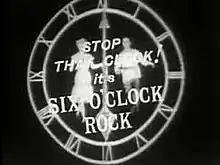Six O'Clock Rock
Six O'Clock Rock was an Australian rock and roll television show broadcast on ABC Television from 28 February 1959 to 1962 at 6 p.m. on Saturdays.
| Six O'Clock Rock | |
|---|---|
 Title card | |
| Created by |
|
| Starring |
|
| Country of origin | Australia |
| Original language | English |
| Release | |
| Original network | ABC Television |
| Original release | 28 February 1959 – 1962 |
Program synopsis
Inspired by the BBC program 6.5 Special, it had a similar format to its rival on TCN-9, Bandstand compered by Brian Henderson. This was ABC-TV's first youth-oriented music program, long before Countdown.
The show initially opened with American girl Ricki Merriman as compère and Johnny O'Keefe and his band The Dee Jays as guests.[1] The Dee Jays consisted of Dave Owens (tenor sax), Johnny "Greeno" Greenan (baritone sax) and Johnny "Catfish" Purser on drums, Keith Williams on bass guitar, and Lou Casch on guitar,[2] Bob "Bluto" Bertles, later a leading jazz player, substituted as the second saxophone. After six shows O'Keefe took over the hosting role.[3] The show usually opened with O'Keefe singing "Weeeeeell, come on everybody it's six o'clock, uh huh huh huh", with The Graduates providing the "bap bap bap bap" background.[1]
The first episode featured Reg Lindsay, The Australian All-Stars, The Graduates, Terry King and Johnny Ball. The dancers in the opening title sequence were Lee Nielson and Milton Mitchell.
Entertainers who got their first big exposure on Six O'Clock Rock include Lonnie Lee,[4] Barry Stanton and Warren Williams. The Delltones also debuted on this show, which was produced by Peter Page.
The show originally contained a mixture of rock and roll and jazz. The jazz was supplied by the Australian All Stars, featuring Don Burrows on alto and baritone sax, Terry Wilkinson on piano, Ron Webber on drums, Fred Logan on bass, and tenor player Dave Rutledge. The jazz musicians were always a bit uncomfortable with their role, and since O'Keefe insisted on deciding who should be on the show, the jazz numbers were few and far between. O'Keefe wanted the show to be all rock music.
O'Keefe left the show in 1961 to move to ATN-7 to compère the more elaborately produced Johnny O'Keefe Show. These later shows were compered by Tanya Halesworth and Chet Clark, as seen in an existing 1961 edition. Six O'Clock Rock closed in 1962 after changing to a 'softer' format with O'Keefe's departure, and suffered from competition from O'Keefe's new show on Channel 7 and Bandstand on Channel 9.
References
- "Television". Johnny Rock'n'Roll. Archived from the original on 12 December 2006. Retrieved 9 February 2007.
- McGrath, Noel (1978). Australian Encyclopedia of Rock. Outback Press. ISBN 086888216X.
- "Johnny O'Keefe". HowlSpace. Archived from the original on 25 January 2007. Retrieved 9 February 2007.
- "Photogallery: The 50s". Australian Broadcasting Corporation. Archived from the original on 14 May 2006. Retrieved 9 February 2007.
Sources
- Bryden-Brown, John (1982). "Terror on TV". JO'K, the Official Johnny O'Keefe Story. Doubleday. ISBN 9780868240862.
External links
- Six O'Clock Rock at IMDb
- Six O'Clock Rock at the National Film and Sound Archive
- 50 Years of ABC-TV Timeline Archived 2007-08-24 at the Wayback Machine